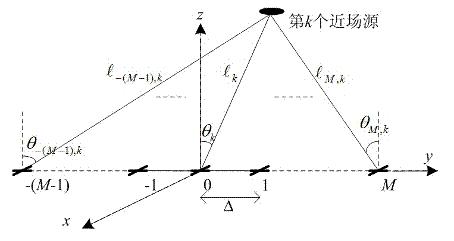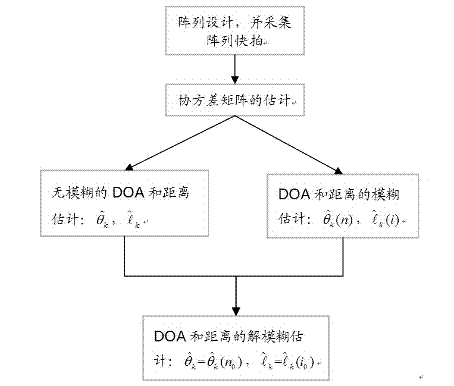Near-field sound source positioning method
A sound source localization and near-field technology, used in localization, measurement devices, instruments, etc.
- Summary
- Abstract
- Description
- Claims
- Application Information
AI Technical Summary
Problems solved by technology
Method used
Image
Examples
Embodiment 1
[0074] Using a uniform linear array composed of multiple pairs of speed sensors can improve the estimation performance of parameters through aperture expansion; in addition, there is no need for multi-dimensional parameter search or calculation of high-order statistics, and automatic pairing of parameter estimation can be realized.
[0075] Near-field sound source localization methods, such as figure 1 As shown, the following steps are taken:
[0076] Step 1: Set up a uniform linear array
[0077] Set up a uniform linear array (K<2M) composed of 2M array elements. The array element interval is Δ, and each array element is an array composed of a pair of speed sensors, pointing to the y-axis and the z-axis respectively.
[0078] Step 2: Build a signal model
[0079] Consider K near-field, narrow-band, incoherent sound source signals incident on the above-mentioned uniform linear array, -π / 2m,k ≤π / 2 means the DOA of the kth near-field source signal relative to the mth array el...
Embodiment 2
[0123] Embodiment 2 (experimental example)
[0124] Set a uniform linear array containing 16 speed sensors (ie M=4), and the signal sampling frequency is f samp =15MHz, and consider two near-field sound sources (k 1 , k 2 ), whose parameters are: ω 1 =0.4πrad / s and ω 2 =0.5πrad / s (that is, the wavelength is λ 1 =100m and λ 2 =80m), θ 1 =25°, θ 2 = 40°, l 1 =2.5λ 1 , l 2 =3.0λ 2 . N=400 snapshots are used to simulate the experimental results of near-field source location. The simulation results are the statistical results of 500 Monte Carlo experiments, such as image 3 , Figure 4 , Figure 5 , Figure 6 .
[0125] in, image 3 , 4 The relationship between the root mean square estimation error of the DOA of the two signal sources and the signal ratio is given, where image 3 for the signal k 1 , Figure 4 for the signal k 2 . We consider three different cases of array element spacing Δ: Δ=λ min / 4, Δ=λ min and Δ=2λ min , where λ min =min{λ 1 ,λ 2}...
PUM
 Login to View More
Login to View More Abstract
Description
Claims
Application Information
 Login to View More
Login to View More - R&D
- Intellectual Property
- Life Sciences
- Materials
- Tech Scout
- Unparalleled Data Quality
- Higher Quality Content
- 60% Fewer Hallucinations
Browse by: Latest US Patents, China's latest patents, Technical Efficacy Thesaurus, Application Domain, Technology Topic, Popular Technical Reports.
© 2025 PatSnap. All rights reserved.Legal|Privacy policy|Modern Slavery Act Transparency Statement|Sitemap|About US| Contact US: help@patsnap.com



